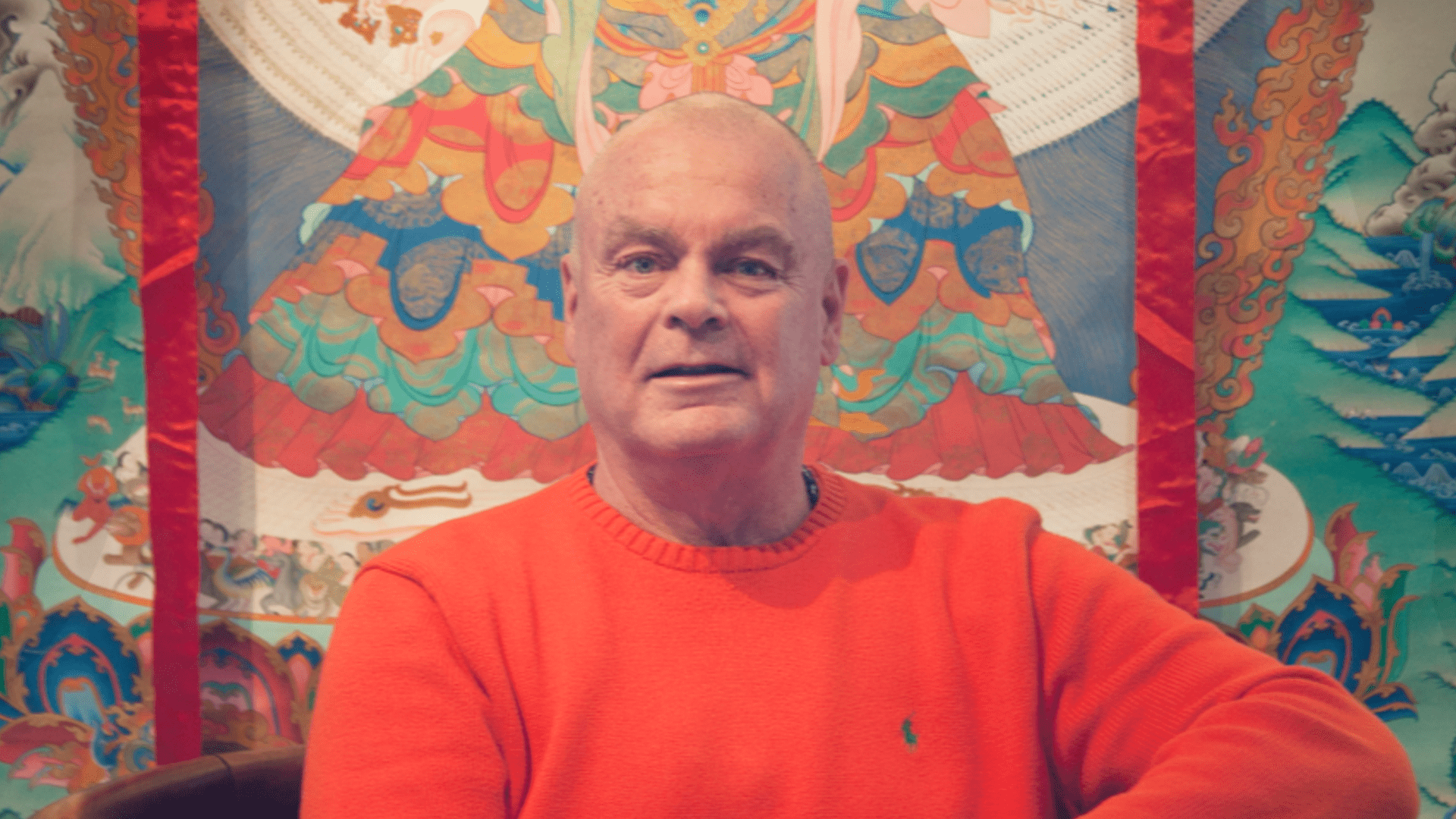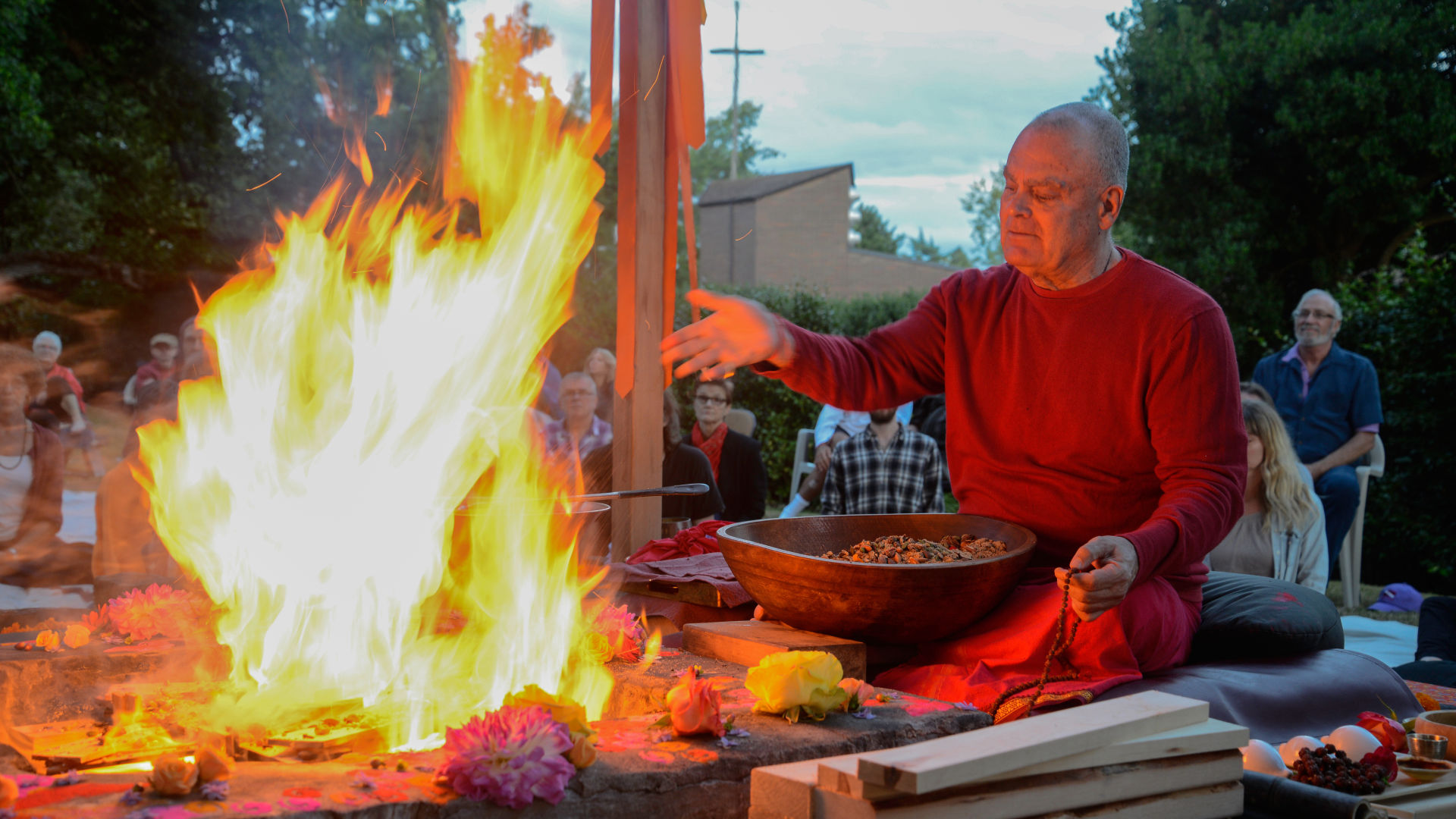Swami Chetanananda (“Swamiji”) is an American spiritual teacher who has spent his life assimilating the great tantric traditions into a new non-dual model of understanding the nature of reality. In the process, he has developed an approach to spiritual work that anyone can practise in the context of everyday life.
Swamiji’s teaching draws from his study of kundalini yoga, Śakta Śaivism, Śrī Vidyā, Vajrayana tantrism, osteopathy, quantum physics, and neuroscience. He teaches that consciousness is in eternal union with respiratory process, which he calls the Breath of Life, and that it can be experienced through contact, alignment and flow with the creative energy. In his view, everything that exists is a manifestation of the Breath of Life: alive, divine and permeated by beauty.
Swamiji is fiercely dedicated to unearthing the most authentic teachings of ancient traditions and mining their essence. He teaches practical techniques for working with creative energy to help students unfold their highest potential to realize what he calls an “unimaginable possibility.”
Swamiji is the author of several books on spirituality published by Rudra Press, including Dynamic Stillness, Vols. I & II ; The Breath of God; Open Heart, Open Mind; The Logic of Love; Choose to Be Happy; Will I Be the Hero of My Own Life? and There Is Only One.
HATHA YOGA
Born and raised in the Midwest, Swamiji began studying and teaching asana practice in 1969, long before yoga became a household word. His experience of yoga informed his life, and the quality of contact he established with his inner self through yoga practice became a touchstone for his spiritual work. In 1971, Swamiji established the first American yoga-based intentional community in Bloomington, Indiana. In the same year, he met his heart guru, Swami Rudrananda (Rudi) of New York City, and began to study with him. Rudi was a disciple of the Siddha Yoga lineage, founded by Bhagavan Nityananda of Ganeshpuri. After Rudi’s passing in 1973, Swamiji became his successor, and established the Nityananda Institute for the development and promotion of yoga-related studies. For 45 years, he headed ashrams, first in Bloomington, then in Cambridge, Massachusetts, and, most recently, in Portland, Oregon. He has also had process centers in Santa Monica, California; Boston; Seattle; and New York City.
While continuing to share the eyes-open kundalini process technique taught by Rudi, Swamiji has refined and elaborated Rudi’s teachings. He offers a practice based on three principles: contact with creative energy, alignment through releasing tensions and blockages, and flow to extend the individual energy into the vast field of universal awareness.
KASHMIR ŚAIVISM AND ŚAKTA ŚAIVISM
Swamiji studied with Swami Muktananda from 1973 to 1982 and took sannyas from him in 1978, when he received the name “Chetanananda,” meaning “the joy of consciousness.” In the course of his studies with Muktananda, Swamiji began in-depth exploration of the non-dual system of Kashmir Śaivism, recognizing in the ancient texts a deep resonance with his own inner experiences. From 1982 to 1986, he was closely associated with Swami Lakshmanjoo in Srinagar, who was the last living lineage holder of the tradition of Abhinavagupta, the foremost proponent of non-dual Śaivism.
Swamiji has since sponsored numerous scholars to help discover new manuscript sources and publish new translations, including the first English translation of the Tantrasāra of Abhinavagupta. For the last 30 years, Swamiji has collaborated with Professor Alexis Sanderson, the most accomplished expert in the field. He currently acts as the chairman of the board of the Institute for Śaiva and Tantric Studies, which was established to support the translation of key Sanskrit sources of the tantric tradition.
Swamiji’s teachings on Kashmir Śaivism convey the essence of this elegant philosophical system in direct and non-technical terms. In 1989, he wrote the first English commentary on the Śiva Sutras in his two-volume book, Dynamic Stillness. He has since also presented commentaries on the Pratyabhijñāhṛdaya, the Spandakārikā, and the Mālinīvijayottara Tantra. Currently, he is in process of writing a commentary and exegesis relating quantum language and mantra that is based on Abhinavagupta’s masterwork, the Tantrāloka.
ŚRĪ VIDYĀ AND THE ŚRĪ CHAKRA PRACTICE
In 1978, while teaching process in Bloomington, Indiana, Swami Chetanananda had a profound vision of the Goddess Tripurasundarī, during which the Goddess transmitted to him her essence mantra. He reported this experience to Swami Muktanananda, who directed him to study with the Brahmin priests at Mookambika Devi Temple, in Karnataka, India. This launched Swamiji’s study of the teachings of Śakta Śaivism in the Śrī Vidyā lineage and his practice of the worship of the Goddess through the Śrī Chakra sadhana.
Swamiji also studied at the seat of the Shankaracharya, the Adi Kamakshi Amman Devi Temple, in Kanchipuram. He received initiation and a Śrī Chakra from the Shankaracharya, which still sits on his altar today. In 2007, Swamiji began practicing the Śrī Chakra sadhana at the great śaktipitha, Kamakhya Temple in Assam, in northern India. He received instruction in the kaula tantric form of the sadhana from Ram Dayal Shastri, a powerful Bihari tantric who received his training in Varanasi. For many years, he regularly went into retreat at Kamakhya and performed havans at the yoni kund with the temple priests.
In December 2013, Swamiji began a formal transmission to students of his understanding of Śrī Vidyā and the Śrī Chakra practice. His teachings, developed from his 40 years of study, are offered in an online program that includes complete instructions and comprehensive resource materials for anyone interested in pursuing this practice.
VAJRAYANA AND THE PACIFICATION OF SUFFERING LINEAGE
In 1974, while traveling in India to gather stories for a book on the life of Nityananda, Swamiji met Kangyur Rinpoche (Longchen Yeshe Dorje), a great master and tertön from Riwoche Monastery in Kham, East Tibet. Swamiji felt a profound and deep heart connection with Kangyur Rinpoche and sought his advice. This was his first close association with the outstanding Tibetan Vajrayana and Dzogchen teachers of our time.
His other connections include: His Eminence Kyabjé Chatral Rinpoche, from whom he received advice on the practice of Vajrakilaya; the Taktser Rinpoche, Thubten Jigme Norbu, the Dalai Lama’s brother, who sat on the board of directors of Swamiji’s ashram in Bloomington, Indiana; His Holiness Ngawang Tenzin Rinpoche of Bhutan; Abbot Khenpo Dondrup Chokyi Nyima Rinpoche of Gemang Dzogchen Monastery in Kham, Tibet; and Khenpo Pema Wangyal, the great Dzogchen master of Kham, who transmitted to Swamiji the essential Dzogchen teachings of Longchenpa.
In 1997, Swamiji met Lama Tsering Wangdu Rinpoche, a highly accomplished practitioner of Chöd and the Shije (Pacification of Suffering) teachings of Padampa Sangye. Swamiji understood that Padampa Sangye’s Chöd teachings and Śaivism shared a common origin, and he began to study with Rinpoche. Over the next several years, Wangdu Rinpoche transmitted to Swamiji the highest teachings of the Nyingma tradition, including the Longchen Nyingthig, Dudjom Rinpoche’s Vajrakilaya teachings of Pudri Rekpung (spu gri reg phung), and the entire Padampa Sangye Shije practice canon. In December 2005, Tsering Wangdu Rinpoche conferred upon Swamiji the title of lineage holder of the Padampa Sangye Pacification of Suffering lineage and gave him the Dharma name of Ösel Dorje Shonnui Tsal.
Swami Chetanananda has supported Wangdu Rinpoche’s residency in the United States, sustained an active practice and teaching program of the Shije and Chöd lineage teachings, and funded translations of key lineage texts including Padampa Sangye’s Mahāmudra, published by Snow Lion Publications in 2008 as The Lion of Siddhas.
OTHER TANTRIC STUDIES
For 45 years, Swami Chetanananda has continued to study the tantric tradition in all its forms, from the plains of North India to Nepal’s Kathmandu Valley and the steppes of Tibet. He has sought out adepts who preserve powerful lineages and absorbed the essence of their practices.
Swamiji spent significant time with several great Indian teachers, including Anandamayi Ma, Sathya Sai Baba, Dadaji of Calcutta, and Gopinath Kaviraj. He has supported the study of the Kubjika tradition and the Kamacharya family of Bhaktapur, who are the last living holders of the royal tradition. Swamiji is also initiated into the lineage of Tyaga Nath Aghori from Pashupatinath in Kathmandu.
HATHA YOGA, OSTEOPATHY, HOMEOPATHY, QIGONG, ASTROLOGY
Under Swamiji’s direction, the Movement Center developed one of the first hatha yoga teacher trainings in the United States. Swamiji personally knew the most influential hatha yoga teachers of our time: Iyengar, Satchitananda, and Desikachar. Currently, he works to support Linda Lack (founder of the Thinking Body, Feeling Mind™ technique) in her work to create a safer and more conscious practice and understanding of the essentials of movement in the development of ourselves as conscious beings.
Swami Chetanananda’s understanding of the Breath of Life has been further influenced by his study of a range of energetic healing systems and modalities. For eighteen years, Swamiji studied with Dr. Rollin Becker, a gifted cranial osteopath, who was Dr. William Garner Sutherland’s assistant in the development of cranial osteopathy and the founder of the Sutherland Cranial Teaching Foundation. Dr. Becker’s work had great impact on Swamiji’s understanding of the three-phased respiratory process as it relates to our human physiology and transitions to kundalini.
Swamiji has a working knowledge of homeopathy and has supported the work of Dr. Sujit Chatterjee, from Mumbai, as well as Nancy Herrick and Roger Morrison of the Hahnemann Medical Clinic in Point Richmond, California. In addition, he studied Qigong with Master Dr. Baolin Wu in Santa Monica, California. Qigong and hatha yoga are today still part of Swamiji’s daily practices.
Swamiji met the great Vedic astrologer and devotee of Bhagavan Nityananda, Chakrapani Ullal, shortly after Rudi died. Chakrapani had been a close friend of Rudi’s and played an essential role in encouraging Swamiji’s connection with Baba Muktananda. Chakrapani also mentored Swamiji in his study of Vedic astrology, which continued over many years. Astrology remains one of Swamiji’s active interests.
Swamiji has traveled extensively in Asia and has a deep appreciation for music and Asian art.

